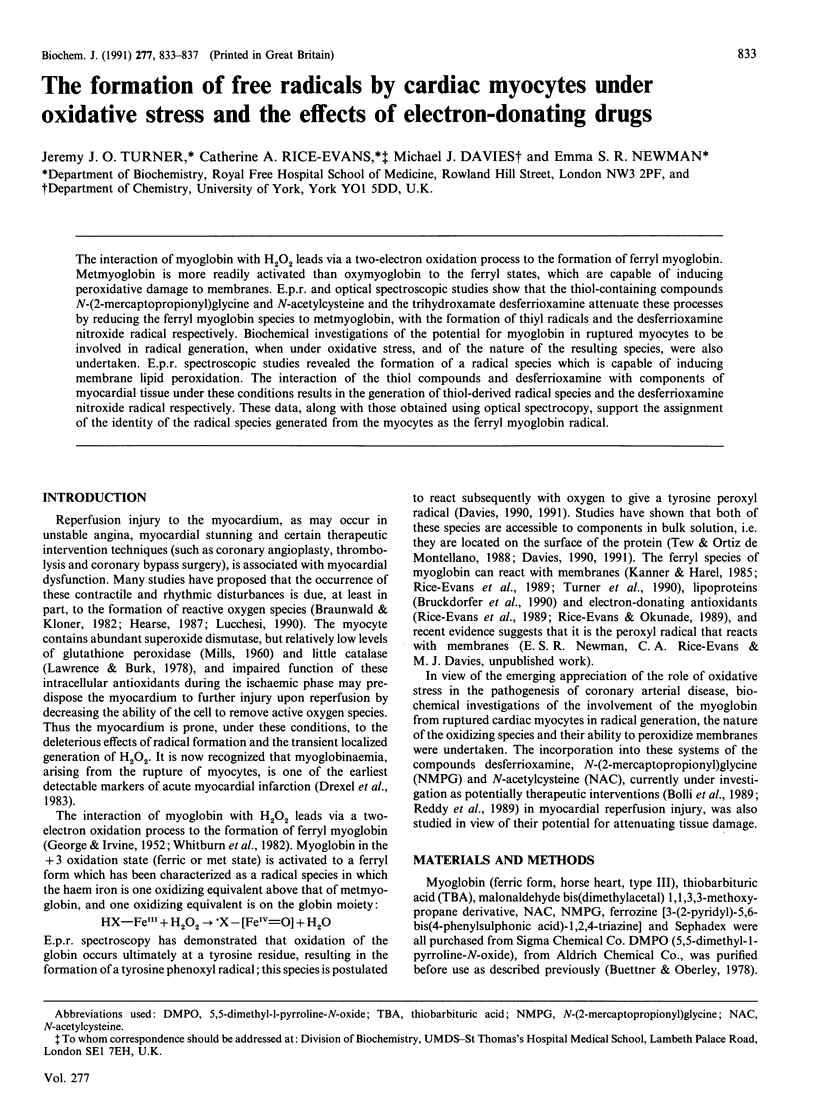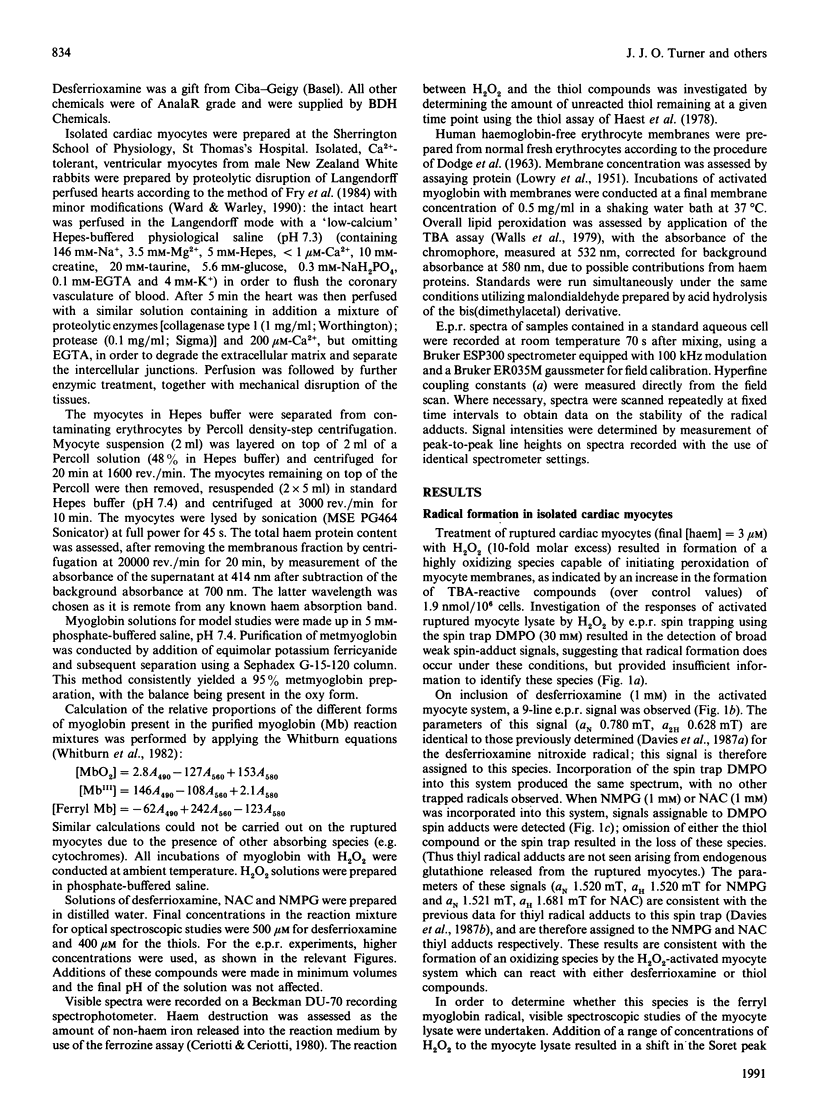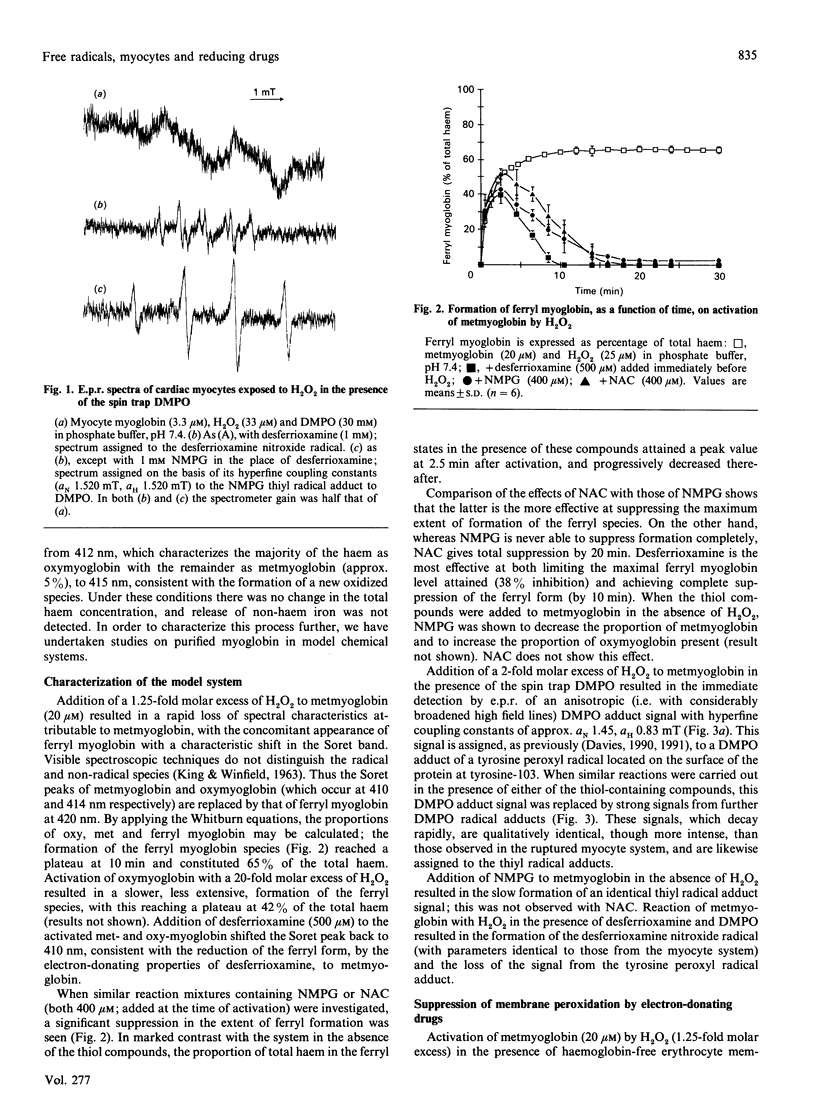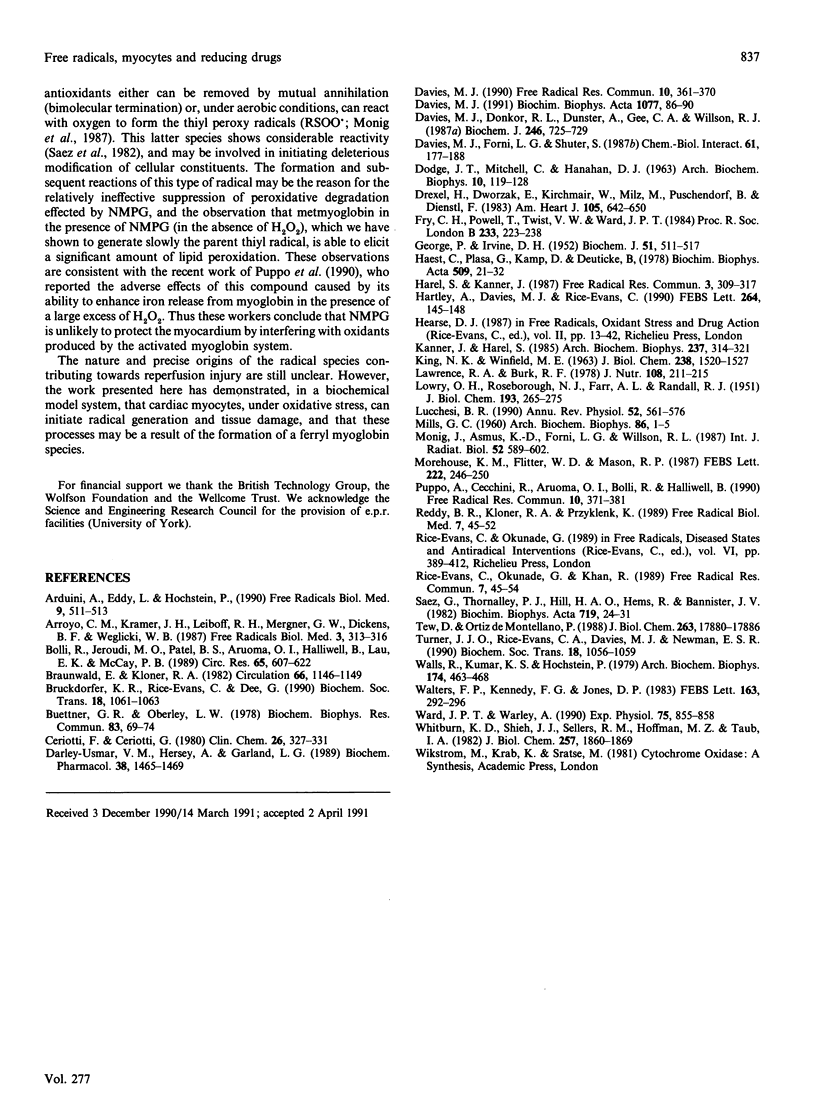Abstract
The interaction of myoglobin with H2O2 leads via a two-electron oxidation process to the formation of ferryl myoglobin. Metmyoglobin is more readily activated than oxymyoglobin to the ferryl states, which are capable of inducing peroxidative damage to membranes. E.p.r. and optical spectroscopic studies show that the thiol-containing compounds N-(2-mercaptopropionyl) glycine and N-acetylcysteine and the trihydroxamate desferrioxamine attenuate these processes by reducing the ferryl myoglobin species to metmyoglobin, with the formation of thiyl radicals and the desferrioxamine nitroxide radical respectively. Biochemical investigations of the potential for myoglobin in ruptured myocytes to be involved in radical generation, when under oxidative stress, and of the nature of the resulting species, were also undertaken. E.p.r. spectroscopic studies revealed the formation of a radical species which is capable of inducing membrane lipid peroxidation. The interaction of the thiol compounds and desferrioxamine with components of myocardial tissue under these conditions results in the generation of thiol-derived radical species and the desferrioxamine nitroxide radical respectively. These data, along with those obtained using optical spectrocopy, support the assignment of the identity of the radical species generated from the myocytes as the ferryl myoglobin radical.
Full text
PDF




Selected References
These references are in PubMed. This may not be the complete list of references from this article.
- Arduini A., Eddy L., Hochstein P. Detection of ferryl myoglobin in the isolated ischemic rat heart. Free Radic Biol Med. 1990;9(6):511–513. doi: 10.1016/0891-5849(90)90130-b. [DOI] [PubMed] [Google Scholar]
- Arroyo C. M., Kramer J. H., Leiboff R. H., Mergner G. W., Dickens B. F., Weglicki W. B. Spin trapping of oxygen and carbon-centered free radicals in ischemic canine myocardium. Free Radic Biol Med. 1987;3(5):313–316. doi: 10.1016/s0891-5849(87)80037-0. [DOI] [PubMed] [Google Scholar]
- Bolli R., Jeroudi M. O., Patel B. S., Aruoma O. I., Halliwell B., Lai E. K., McCay P. B. Marked reduction of free radical generation and contractile dysfunction by antioxidant therapy begun at the time of reperfusion. Evidence that myocardial "stunning" is a manifestation of reperfusion injury. Circ Res. 1989 Sep;65(3):607–622. doi: 10.1161/01.res.65.3.607. [DOI] [PubMed] [Google Scholar]
- Braunwald E., Kloner R. A. The stunned myocardium: prolonged, postischemic ventricular dysfunction. Circulation. 1982 Dec;66(6):1146–1149. doi: 10.1161/01.cir.66.6.1146. [DOI] [PubMed] [Google Scholar]
- Bruckdorfer K. R., Jacobs M., Rice-Evans C. Endothelium-derived relaxing factor (nitric oxide), lipoprotein oxidation and atherosclerosis. Biochem Soc Trans. 1990 Dec;18(6):1061–1063. doi: 10.1042/bst0181061. [DOI] [PubMed] [Google Scholar]
- Buettner G. R., Oberley L. W. Considerations in the spin trapping of superoxide and hydroxyl radical in aqueous systems using 5,5-dimethyl-1-pyrroline-1-oxide. Biochem Biophys Res Commun. 1978 Jul 14;83(1):69–74. doi: 10.1016/0006-291x(78)90398-4. [DOI] [PubMed] [Google Scholar]
- Ceriotti F., Ceriotti G. Improved direct specific determination of serum iron and total iron-binding capacity. Clin Chem. 1980 Feb;26(2):327–331. [PubMed] [Google Scholar]
- DODGE J. T., MITCHELL C., HANAHAN D. J. The preparation and chemical characteristics of hemoglobin-free ghosts of human erythrocytes. Arch Biochem Biophys. 1963 Jan;100:119–130. doi: 10.1016/0003-9861(63)90042-0. [DOI] [PubMed] [Google Scholar]
- Darley-Usmar V. M., Hersey A., Garland L. G. A method for the comparative assessment of antioxidants as peroxyl radical scavengers. Biochem Pharmacol. 1989 May 1;38(9):1465–1469. doi: 10.1016/0006-2952(89)90186-x. [DOI] [PubMed] [Google Scholar]
- Davies M. J. Detection of myoglobin-derived radicals on reaction of metmyoglobin with hydrogen peroxide and other peroxidic compounds. Free Radic Res Commun. 1990;10(6):361–370. doi: 10.3109/10715769009149905. [DOI] [PubMed] [Google Scholar]
- Davies M. J., Donkor R., Dunster C. A., Gee C. A., Jonas S., Willson R. L. Desferrioxamine (Desferal) and superoxide free radicals. Formation of an enzyme-damaging nitroxide. Biochem J. 1987 Sep 15;246(3):725–729. doi: 10.1042/bj2460725. [DOI] [PMC free article] [PubMed] [Google Scholar]
- Davies M. J., Forni L. G., Shuter S. L. Electron spin resonance and pulse radiolysis studies on the spin trapping of sulphur-centered radicals. Chem Biol Interact. 1987 Feb;61(2):177–188. doi: 10.1016/0009-2797(87)90038-x. [DOI] [PubMed] [Google Scholar]
- Davies M. J. Identification of a globin free radical in equine myoglobin treated with peroxides. Biochim Biophys Acta. 1991 Mar 8;1077(1):86–90. doi: 10.1016/0167-4838(91)90529-9. [DOI] [PubMed] [Google Scholar]
- Drexel H., Dworzak E., Kirchmair W., Milz M. M., Puschendorf B., Dienstl F. Myoglobinemia in the early phase of acute myocardial infarction. Am Heart J. 1983 Apr;105(4):642–651. doi: 10.1016/0002-8703(83)90489-1. [DOI] [PubMed] [Google Scholar]
- Fry C. H., Powell T., Twist V. W., Ward J. P. Net calcium exchange in adult rat ventricular myocytes: an assessment of mitochondrial calcium accumulating capacity. Proc R Soc Lond B Biol Sci. 1984 Dec 22;223(1231):223–238. doi: 10.1098/rspb.1984.0091. [DOI] [PubMed] [Google Scholar]
- GEORGE P., IRVINE D. H. The reaction between metmyoglobin and hydrogen peroxide. Biochem J. 1952 Nov;52(3):511–517. doi: 10.1042/bj0520511. [DOI] [PMC free article] [PubMed] [Google Scholar]
- Haest C. W., Plasa G., Kamp D., Deuticke B. Spectrin as a stabilizer of the phospholipid asymmetry in the human erythrocyte membrane. Biochim Biophys Acta. 1978 May 4;509(1):21–32. doi: 10.1016/0005-2736(78)90004-4. [DOI] [PubMed] [Google Scholar]
- Hartley A., Davies M., Rice-Evans C. Desferrioxamine as a lipid chain-breaking antioxidant in sickle erythrocyte membranes. FEBS Lett. 1990 May 7;264(1):145–148. doi: 10.1016/0014-5793(90)80786-i. [DOI] [PubMed] [Google Scholar]
- KING N. K., WINFIELD M. E. The mechanism of metmyoglobin oxidation. J Biol Chem. 1963 Apr;238:1520–1528. [PubMed] [Google Scholar]
- Kanner J., Harel S. Desferrioxamine as an electron donor. Inhibition of membranal lipid peroxidation initiated by H2O2-activated metmyoglobin and other peroxidizing systems. Free Radic Res Commun. 1987;3(1-5):309–317. doi: 10.3109/10715768709069798. [DOI] [PubMed] [Google Scholar]
- Kanner J., Harel S. Initiation of membranal lipid peroxidation by activated metmyoglobin and methemoglobin. Arch Biochem Biophys. 1985 Mar;237(2):314–321. doi: 10.1016/0003-9861(85)90282-6. [DOI] [PubMed] [Google Scholar]
- LOWRY O. H., ROSEBROUGH N. J., FARR A. L., RANDALL R. J. Protein measurement with the Folin phenol reagent. J Biol Chem. 1951 Nov;193(1):265–275. [PubMed] [Google Scholar]
- Lawrence R. A., Burk R. F. Species, tissue and subcellular distribution of non Se-dependent glutathione peroxidase activity. J Nutr. 1978 Feb;108(2):211–215. doi: 10.1093/jn/108.2.211. [DOI] [PubMed] [Google Scholar]
- Lucchesi B. R. Modulation of leukocyte-mediated myocardial reperfusion injury. Annu Rev Physiol. 1990;52:561–576. doi: 10.1146/annurev.ph.52.030190.003021. [DOI] [PubMed] [Google Scholar]
- MILLS G. C. Glutathione peroxidase and the destruction of hydrogen peroxide in animal tissues. Arch Biochem Biophys. 1960 Jan;86:1–5. doi: 10.1016/0003-9861(60)90357-x. [DOI] [PubMed] [Google Scholar]
- Morehouse K. M., Flitter W. D., Mason R. P. The enzymatic oxidation of Desferal to a nitroxide free radical. FEBS Lett. 1987 Oct 5;222(2):246–250. doi: 10.1016/0014-5793(87)80379-4. [DOI] [PubMed] [Google Scholar]
- Mönig J., Asmus K. D., Forni L. G., Willson R. L. On the reaction of molecular oxygen with thiyl radicals: a re-examination. Int J Radiat Biol Relat Stud Phys Chem Med. 1987 Oct;52(4):589–602. doi: 10.1080/09553008714552081. [DOI] [PubMed] [Google Scholar]
- Puppo A., Cecchini R., Aruoma O. I., Bolli R., Halliwell B. Scavenging of hypochlorous acid and of myoglobin-derived oxidants by the cardioprotective agent mercaptopropionylglycine. Free Radic Res Commun. 1990;10(6):371–381. doi: 10.3109/10715769009149906. [DOI] [PubMed] [Google Scholar]
- Reddy B. R., Kloner R. A., Przyklenk K. Early treatment with deferoxamine limits myocardial ischemic/reperfusion injury. Free Radic Biol Med. 1989;7(1):45–52. doi: 10.1016/0891-5849(89)90099-3. [DOI] [PubMed] [Google Scholar]
- Rice-Evans C., Okunade G., Khan R. The suppression of iron release from activated myoglobin by physiological electron donors and by desferrioxamine. Free Radic Res Commun. 1989;7(1):45–54. doi: 10.3109/10715768909088161. [DOI] [PubMed] [Google Scholar]
- Saez G., Thornalley P. J., Hill H. A., Hems R., Bannister J. V. The production of free radicals during the autoxidation of cysteine and their effect on isolated rat hepatocytes. Biochim Biophys Acta. 1982 Oct 28;719(1):24–31. doi: 10.1016/0304-4165(82)90302-6. [DOI] [PubMed] [Google Scholar]
- Tew D., Ortiz de Montellano P. R. The myoglobin protein radical. Coupling of Tyr-103 to Tyr-151 in the H2O2-mediated cross-linking of sperm whale myoglobin. J Biol Chem. 1988 Nov 25;263(33):17880–17886. [PubMed] [Google Scholar]
- Turner J. J., Rice-Evans C. A., Davies M. J., Newman E. S. Free radicals, myocytes and reperfusion injury. Biochem Soc Trans. 1990 Dec;18(6):1056–1059. doi: 10.1042/bst0181056. [DOI] [PubMed] [Google Scholar]
- Walls R., Kumar K. S., Hochstein P. Aging human erythrocytes. Differential sensitivity of young and old erythrocytes to hemolysis induced by peroxide in the presence of thyroxine. Arch Biochem Biophys. 1976 Jun;174(2):463–468. doi: 10.1016/0003-9861(76)90374-x. [DOI] [PubMed] [Google Scholar]
- Walters F. P., Kennedy F. G., Jones D. P. Oxidation of myoglobin in isolated adult rat cardiac myocytes by 15-hydroperoxy-5,8,11,13-eicosatetraenoic acid. FEBS Lett. 1983 Nov 14;163(2):292–296. doi: 10.1016/0014-5793(83)80838-2. [DOI] [PubMed] [Google Scholar]
- Ward J. P., Warley A. Subcellular elemental composition in isolated cardiac myocytes from rabbit following chronic potassium depletion and acute repletion, studied by X-ray microanalysis. Exp Physiol. 1990 Nov;75(6):855–858. doi: 10.1113/expphysiol.1990.sp003469. [DOI] [PubMed] [Google Scholar]
- Whitburn K. D., Shieh J. J., Sellers R. M., Hoffman M. Z., Taub I. A. Redox transformations in ferrimyoglobin induced by radiation-generated free radicals in aqueous solution. J Biol Chem. 1982 Feb 25;257(4):1860–1869. [PubMed] [Google Scholar]


